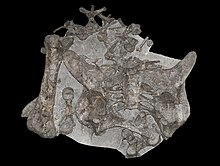
Back مذيلة كثيرة النقط Arabic Dacentrurus armatus Catalan Dacentrurus Czech Dacentrurus German Dacentrurus armatus Spanish داسنتروس FA Dacentrurus Finnish Dacentrurus French דסנתרורוס HE Dacentrurus Hungarian
| Dacentrurus Temporal range: Late Jurassic, - Early Cretaceous
| |
|---|---|

| |
| Holotype specimen (NHMUK OR 46013), Natural History Museum, London | |
| Scientific classification | |
| Domain: | Eukaryota |
| Kingdom: | Animalia |
| Phylum: | Chordata |
| Clade: | Dinosauria |
| Clade: | †Ornithischia |
| Clade: | †Thyreophora |
| Clade: | †Stegosauria |
| Family: | †Stegosauridae |
| Subfamily: | †Dacentrurinae |
| Genus: | †Dacentrurus Lucas, 1902 |
| Species: | †D. armatus
|
| Binomial name | |
| †Dacentrurus armatus (Owen, 1875 [originally Omosaurus])
| |
| Synonyms | |
| |
Dacentrurus (meaning "tail full of points"), originally known as Omosaurus, is a genus of stegosaurian dinosaur from the Late Jurassic and perhaps Early Cretaceous (154 - 140 mya) of Europe.
Its type species, Omosaurus armatus, was named in 1875, based on a skeleton found in a clay pit in the Kimmeridge Clay in Swindon, England. In 1902 the genus was renamed Dacentrurus because the name Omosaurus had already been used for a phytosaur. After 1875, half a dozen other species would be named but perhaps only Dacentrurus armatus is valid.
Dacentrurus was the largest stegosaur measuring around 8–9 metres (26–30 ft) long and weighing up to 5–7.4 metric tons (5.5–8.2 short tons). Finds of this animal have been limited, so much of its appearance is uncertain and its relationship with other members of the Dacentrurinae are contentious. Some researchers suggest that Miragaia longicollum represents a junior synonym of this taxon.[1]
- ^ Sánchez-Fenollosa, S.; Escaso, F.; Cobos, A. (2024). "A new specimen of Dacentrurus armatus Owen, 1875 (Ornithischia: Thyreophora) from the Upper Jurassic of Spain and its taxonomic relevance in the European stegosaurian diversity". Zoological Journal of the Linnean Society. doi:10.1093/zoolinnean/zlae074.